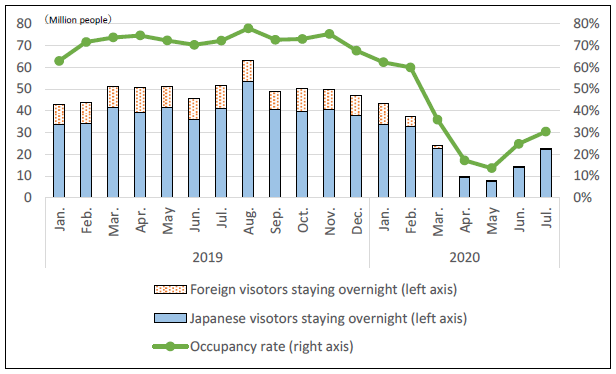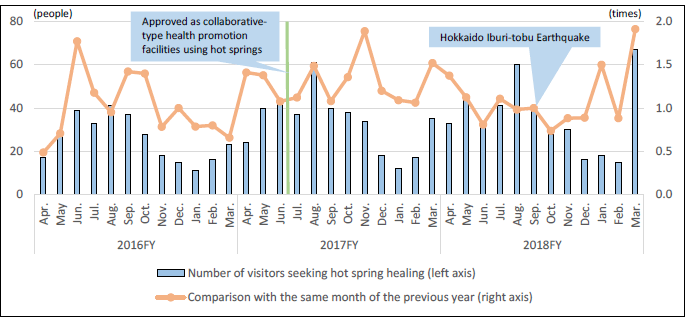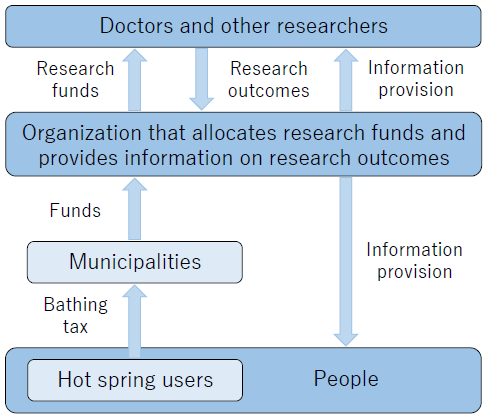1. Hot Spring Healing as the Original Overnight Tourism
Since February 2020, due to the spread of COVID-19, accommodation facilities have seen a significant decrease in the number of overnight visitors compared to the figures in the previous year. However, the number is showing signs of recovery nationwide thanks to various tourism campaigns by local governments targeting local residents and the commencement of the Go To Travel Campaign by the Japan Tourism Agency on July 22 (Fig. 1). At the meeting held on July 27, the Tourism Strategy Promotion Council announced a policy for new patterns of tourism on the premise that longer stays would contribute to reduction of COVID-19 infection risk, such as "work-ations," i.e. teleworking while enjoying leisure time at a hot spring or other resort (Note 1). Nevertheless, under the current circumstances where the end of the COVID-19 pandemic is not in sight and entry of foreign tourists is not permitted, the number of overnight visitors is unlikely to recover to the pre-pandemic level within the short term.

https://www.mlit.go.jp/kankocho/siryou/toukei/shukuhakutoukei.html
(viewed on September 10, 2020)
Japan has a tradition of hot spring healing, that is, Japanese people stay at hot spring resorts not only for the treatment of a disease or injury but for the promotion of good health by reducing the tiredness of the mind and body. However, it is rather difficult for modern working people to take a three- to four-week-long holiday for hot spring healing, unlike people in the Edo era. These days, repeated, short-term stays, such as day trips or weekend trips have replaced the former weeks-long stays of the Edo era, providing much of the benefit of the longer stays, but such recently termed "modern hot spring healing" and "new hot spring healing," which adds the enjoyment of local resources to the hot spring experience, have gained prominence. In addition, tours to natural areas focused on enjoying the natural environment, hot springs, and healthy food which together refresh both the body and mind are being promoted as "health tourism."
Germany, France and other European countries position hot spring treatments as medical treatments based on scientific evidence, and effectively utilize hot springs for treatment under their medical insurance systems, which cover hot spring treatments. Japan also has an official support system under which the use of any of the health promotion facilities including hot springs that are approved by the Ministry of Health, Labour and Welfare for hot spring treatments allows part of the expenses to be deducted as medical expenses from the patient's income tax. Initially there was very little use of the system, partly because the system was not widely known, but Toyotomi Hot Springs (Toyotomi Town in Hokkaido) after being approved as a collaborative-type health promotion facilities that utilize hot springs for treatment, where scientific evidence on the effects on dermatological diseases has been accumulated, allowing doctors to recommend the hot springs as medical treatment, saw increases in the number of visitors seeking hot spring healing based on doctors' information (Fig. 2).

Hereinafter, I will consider measures for establishing new forms of hot spring healing that organically combines an increase in evidence accumulated on the effects of hot spring treatments with programs centered on local resources of hot spring resorts in order to achieve regional revitalization through promoting tourism involving overnight or longer stays.
2. Hot Spring Treatments Not Falling under Medical Practice
Hot springs have various characteristics in terms of mineral ingredients, temperature, color and smell and are categorized into ten types depending on the content and quantity of these characteristics. Each type of spring quality shows the indications for the effects of hot spring treatment, but hot spring treatments are not recognized as medical practice at universities. In the Medical Regulations, which were established with the introduction of modern medicine to directly treat diseases in the Meiji era and which serve as the basis for policies on health administrative organizations, medical education, hospitals, doctors and pharmaceutical affairs, hot spring treatments are positioned as a traditional folk remedy and do not fall under established medical practice.
On the other hand, Dr. Erwin von Bälz (1849-1913), a German doctor employed by the Meiji government, and others, studied hot spring treatments in Japan. Some effects of hot springs are traditionally known, but there are many questions that have not yet been ascertained scientifically (Note 2). The Japanese Society of Balneology, Climatology and Physical Medicine (hereinafter referred to as the "Society") and the Japan Health & Research Institute have carried out continuous research on hot spring medical treatment. There are doctors who have received training in balneology, climatology and physical medicine and are approved by the Society as doctors who can provide medical instructions to persons seeking hot spring healing. There are also doctors who are approved by the Society as doctors with a certain level of clinical experience in hot spring treatments from within the pool of doctors who are qualified to prescribe hot spring treatments. If a person has received hot spring treatments based on a written instruction prepared by a doctor at any of the 22 health promotion facilities that utilize hot springs as treatment nationwide (as of April 1, 2020), part of the expenses may be deducted as medical expenses from his/her income tax.
However, as hot spring treatments do not fall under established medical practice, there is little chance to study them in university medical courses, which are generally based on modern Western medicine. Doctors other than those qualified to prescribe hot spring treatments by the Society are unaware of evidence of the effects of hot spring treatments and never recommend hot spring treatments to their patients. Overnight visitors to hot spring resorts may have sufficient information on the resorts as tourist sites but generally have only limited information on the treatment effects of specific hot spring resorts (Note 3).
3. To Strengthen the System for Accumulating and Disseminating Evidence on the Effects of Hot Spring Treatments
In Germany and France, where hot spring treatments are covered by their medical insurance systems, many people receive hot spring treatments. In Japan as well, Toyotomi Hot Springs is welcoming an increasing number of people who visit for the purpose of hot spring healing based on doctor recommendations. Additionally, promotional efforts have been undertaken to encourage stays at hot spring resorts, as represented in such branding terms as "modern" or "new hot spring healing" or "health tourism," and research on hot spring medical treatment has also been carried out. Strengthening of the relevant systems will facilitate the accumulation and dissemination of evidence on the effects of hot spring treatments that will communicate the medical benefits to doctors and the general public, further popularizing treatments at health promotion facilities that utilize hot springs and encouraging people to pursue evidence-based hot spring healing.
In France, the French Association for Thermal Research is providing subsidies to research projects studying the treatment effects of hot springs with funds collected from every hot spring patient and resort, and is providing information to doctors and the general public, with the aim of communicating the concrete benefits of hot spring treatments. As the French Association for Thermal Research, a nationwide organization, unilaterally allocates such subsidies and provides information, the effective, large-scale accumulation and dissemination of evidence is possible.
It is also desirable to strengthen the system in Japan for the accumulation and dissemination of evidence, such as by creating a nationwide organization which effectively allocates funds from hot spring patients and other beneficiaries towards research on the effects of hot spring treatments and to communicating research outcomes (Fig. 3). One of the options for raising funds is to increase the bathing tax levied on mineral spring bath guests. However, as the bathing tax is a municipal tax, it will be difficult to increase the tax rate uniformly nationwide. It may be more practical to target specific municipalities and facilities and consider measures to collect funds from users of relevant hot springs.

4. Establishing New Forms of Hot Spring Healing that Organically Combine Local Resources and Evidence on Hot Spring Treatments
After accumulating and sharing the evidence on the effects of hot spring therapy, what kind of efforts can be expected from each hot spring resorts? There are approximately 3,000 hot spring resorts nationwide and the quality of the spring itself and the surrounding environment differ for each resort. Hot spring resorts for treatment, which are characterized by unique spring quality which have long been used for medical treatments, also tend to be used differently from hot spring resorts for recreation, where the hot springs came to be used later, as simply one of the tourist attractions of the facility.
For treatment-based resorts, emphasizing the evidence for any treatment effects will enhance the appeal of the site as a therapeutic bath. The appeal may be further increased by including local resources in tour packages, such as walking tours and cultural experiences that take advantage of rich natural environments and healthy, locally-sourced cuisine. For recreation-based resorts, tour programs that combine hot springs with local resources will further strengthen bonds between hot springs and surrounding areas as appealing tourist sites. On the other hand, in order to attract guests for longer stays, simply providing time and space to enjoy the facilities freely without any regimented tours may be highly valued. It is also important for accommodation facilities to devise accommodation plans that provide discounts for guests that stay for two or more nights in a row, or to prepare flexible meal plans, for example by separating accommodation fees and meal fees.
New hot spring healing and health tourism are meant to refresh one's body and mind by enjoying hot springs, nature and food, etc., and finding the best methods of combining medical treatments using hot springs with recreational activities based on local resources is the key. Establishing scientific evidence for the benefits in the form of medical treatments, reduced stress and refreshment of "new hot spring healing" will aid in both attracting health tourists and in improving the programs that are offered by the industry. (Note 4). It is hoped that hot spring resorts will first strengthen their systems for accumulating and disseminating evidence and scientifically reevaluate the effects of the treatments that hot springs allow for, and then respectively establish new forms of hot spring healing that are combined organically with other local resources. These efforts will allow the tourism industry to shift their focus from quantity to quality, instead of merely waiting for increases in the number of guests.


